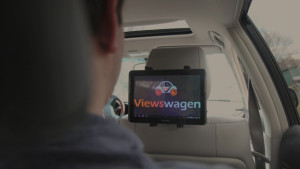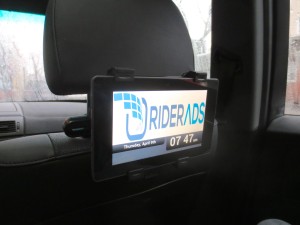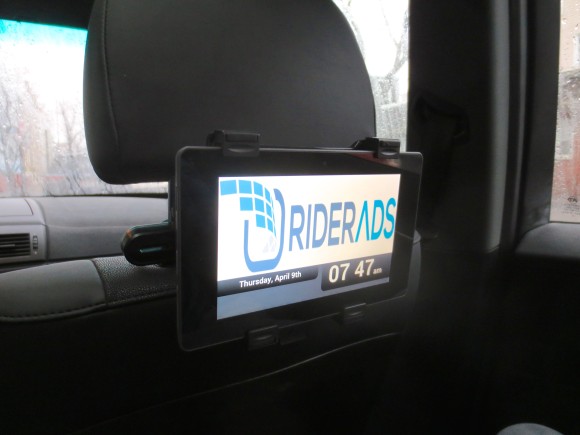James Bellefeuille is an Uber driver for a living, though he admits that what he earns is not much to live on.
Yet in the new sharing economy, there’s hope for people like Bellefeuille who can bring some innovation and entrepreneurialism to the marketplace.
Bellefeuille this week is launching a video advertising service aimed at enabling ridesharing drivers to make money off display ads streamed on a tablet device hung over the back of the headrest for rear seat passengers to watch.
He’s also created a project called Sharesurance, a free monthly insurance report for ridesharing drivers, which he believes will help drivers comply with emerging regulations regarding personal insurance policies and commercial activities – as well as help him sell display ads.
Bellefeuille is one of several people making side money off the growing ridesharing trend, with reports of rideshare drivers doing everything from selling jewelry to marketing their professional services to make an extra dollar while providing rides for a fee.

A PricewaterhouseCoopers survey out in April showed 72 percent of those who responded to a national poll said they expect to become part of the sharing economy in the next two years.
The sharing economy has enough of an interest from insurance regulators that the National Association of Insurance Commissioners has a working group chaired by California Insurance Commissioner Dave Jones dedicated to dealing with the topic.
Trending
In what could be called a trend within a trend, Bellefeuille believes video ads in cars carrying Uber and Lyft passengers will soon be as commonplace as the screens you see in the back of taxis in many cities.
Another small startup called RiderAds is undertaking a similar project in the Boston region, and some individual ridesharing drivers around the country have independently displayed their own ads via tablets or iPads.
Bellefeuille used to work for small digital agency called AttorneySync, which provides online marketing for attorneys, but he said he was fired in September for performance reasons. He did not agree with the reasons.
He already drove for Uber part-time, so with few immediate options available he made the move to full-time rideshare driving. It turns out the firing was the creative push he needed.
Inspiration hit Bellefeuille, who drives in Chicago, Ill., while at his favorite restaurant in the Windy City, Zizi’s Cafe in Lincoln Park. The restaurant owner asked him if he could put a few menus in the back of his car.
Soon some passengers visiting Chicago from New York asked for a dinner recommendation, a common question he gets when giving rides.
“I always recommend Zizi’s, but having the menus in the back of the car had a much stronger effect,” he said. “They asked me to drop them off there. It was then that I realized the power of rideshare advertising, and the concept for Viewswagen was born.”
Viewswagen Inc., which launches this week, will begin placing advertising on tablets in Uber cars around Minneapolis, Minn.
Drivers can download the app, and then can get paid roughly $3 per hour, according to a revenue share calculation based on impression rates – a driver in bustling San Francisco may have more impression rates than, say, a driver on Boise, Idaho.
Viewswagen’s so-called “TripIntent” technology will display ads on the tablet that are relevant to the trip.
For example, take a passenger who hails a rideshare driver for a ride to Target. As the ride gets under way the tablet will display ads for General Mills cereal products, or popular household cleaners, which can be found at the large retailer.
The tablet is tethered wirelessly to the driver’s smartphone. The technology keys in on the address that the driver punches into the GPS, in addition to other cues that are available during the trip.
Bellefeuille wouldn’t detail exactly how it all works, he cited proprietary concerns, but he did say Viewswagen doesn’t collect any personal information about passengers to avoid potential privacy issues.
He described the ultimate goal of Viewswagen: “We’re going to provide a demand-side network that connects advertisers to drivers.”
Unlike a lot of technology developers, Bellefeuille and partners Eugene Kurdzesau , a programmer, and Robert Flessner, who has a background in IT, haven’t been too quiet about their goals.
Enough buzz was generated about the startup that Viewswagen was featured in a recent Forbes article. The exposure evidently helped.
“We had a number of potential investors contact us and we had a number of advertisers contact us and we had a ton of drivers sign up,” said Bellefeuille, who said he considers himself “the poorest guy ever to be quoted in Forbes.”
Display advertising in the back of hired vehicles isn’t new. Anyone who has taken a cab in a big city knows this.
Before Viewswagen emerged some rideshare drivers were already going out on their own by generating and selling video ads with the help of creative marketplace websites like Fiverr.com.
Rideshare World
Video ads are just the latest movement in an entrepreneurial environment that seems to be fostered in the ridesharing world, said Harry Campbell, a Newport Beach, Calif. resident, who goes by the handle “The Rideshare Guy.”
Campbell, who wrote the Forbes article that featured Viewswagen, said he has 100,000 monthly visits to his website, many of them rideshare drivers looking for the latest information, such as what Uber’s plans are for rates, new laws and regulations, the latest trends.
“Going forward I think we’re going to see a lot of companies and startups start to emerge to really take advantage of (video advertising),” said Campbell, who writes five columns per month for Forbes on ridesharing and also drives for Uber and Lyft part-time. “For drivers I see it as a good thing. I see it as a way to diversify their income.”
Opportunism, which seems to go hand-in-hand with the sharing economy, may be partly motivating these new endeavors, but it may be due in part to pressures like declining driver earnings. Uber has been lowering rates by 20 percent or more in many areas over the past year.
“Drivers are really at the mercy of Uber,” Campbell said. “If Uber lowers rates, there’s not much you can do.”
Campbell hears regularly from rideshare drivers looking to earn extra by selling jewelry and other merchandise out of their car trunk, or those who actively network or promote side businesses – DJs, artists, bands, masseuses, real estate agents, errand runners.
Having a side gig as a rideshare driver has become so common, Campbell said, that “One of the questions passengers often ask is ‘What else do you do beside your Uber driving?'”
The advertising angle may appeal to many drivers. It doesn’t require special skills, and there are a lot of potential consumer eyeballs. At the beginning of the year it was estimated Uber had well over 160,000 drivers worldwide, and that the company was adding tens of thousands of drivers each month. That’s a big audience.
Much like the ridesharing trend itself, the upside potential is apparent.
Hurdles
“I see some pretty big hurdles,” Campbell cautioned.
Uber or Lyft may not like sitting on the sidelines as drivers earn ad revenues.
“How does Uber respond to these video and display ads in the back of cars?” was the question Campbell posed.
Uber or Lyft did not reply to requests for comment for this story.
Bellefeuille said he hasn’t worked with either company on either Viewswagen or Sharesurance.
However, if one of the companies did decide they want in on some ad revenues, or the companies decide to stop drivers from displaying ads, they could open themselves up to more fights like the ones they’re in now to determine if their driver partners are actually employees or independent contractors.
U.S judges in California in March ruled that a jury must decide whether Uber and Lyft drivers are independent contractors or employees in separate cases that may have serious implications for the ridesharing companies.
Beyond legal issues some passengers may just find video ads in poor taste.
Adman Barry Cohen, owner of AdLab Media, said what works for taxis may not work for rideshare drivers if the passengers who use services like Uber and Lyft do so anticipating an experience that’s completely different from a cab ride.
Cohen, author of “10 Ways to Screw Up an Ad Campaign,” added that such display advertising has been done for a while with varying success in taxis, supermarket carts, park benches and even urinals.
“Intrusion is the key word here,” he said. “Busy business people like to get work done when someone else is driving. The ads would be distracting to most. The contemporary concept of placing only relevant ads in front of a select audience may work when you are on your iPhone, but here again, you have chosen to visit that website. You did not choose to have your ride interrupted.”
Bellefeuille hopes to counter any intrusive feelings by making the ads and tablets interactive.
“We offer the option for advertisers to create their own creative and landing pages,” he said. “Additionally we provide fun and interesting non-advertising content to keep riders engaged.”
That may make the ads more acceptable, but it still may not work out so well, Cohen said.
“I agree that placing the ads in the context of an information or entertainment medium makes them more acceptable,” Cohen said. “However, many riders would probably still prefer to be able to turn off the picture, video or audio. As a result, the advertiser cannot promise it has reached the audience.”
Anthony Maze, who has been driving for both Uber and Lyft in San Diego, Calif. since 2013, sees in-vehicle advertising as a downside for passengers.
“From the passenger standpoint, it could be perceived as more of a push back into the taxi cab style of transportation,” Maze said. “For example, look at yellow cab in Las Vegas. As soon as you sit in the seat, you’re staring at a plastic wall of advertisement cards for all of the shows on the strip or the clubs. It’s tacky.”

RiderAds, the video ad startup in Boston, has tested rider reactions, according to owner Tyler Sipprelle.
Sipprelle has given rides to Uber passengers with the ads displayed to be sure the experience wouldn’t prompt riders to give negative ratings to drivers.
“Passengers get in the back seat and they act like it’s totally normal,” Sipprelle said.
RiderAds
Sipprelle, a first-year MBA student at Harvard Business School, and four partners pooled some money for the low-investment venture and are launching a pilot program within the next week using 10 drivers in the Boston area.
They have 15 rotating ad spots on tablets running for 10 seconds each – 12 are advertisers, and three are house ads for RiderAds.
Like Viewswagen, the tablets will be interactive, and will offer useful widgets like weather or news, Sipprelle said.
RiderAds is paying drivers $100 to $200 per month, and charging advertisers $10 to $25 per 1,000 impressions, which Sipprelle feels is consistent with rates for other forms of captive audience advertising.
Sipprelle believes that arrangement will entice rideshare drivers.
“Drivers want the guaranteed amount of money rather than something that’s pay-for-performance,” Sipprelle said.
RiderAds is initially focused on the Boston, so most advertisers signed up so far have been local businesses, like kickboxing studios, restaurants and DJ’s, he said.
All tablets are GPS-enabled with the ability to generate targeted ads based on locale or destination, which Sipprelle said is the next step following the pilot program.
While the emerging video ad business isn’t capital-intensive, he is seeking venture capital to help expand.
“We’re totally self-funded at the moment,” Sipprelle said. “We’re definitely going to be looking to raise venture financing in the next couple of months.”
A least one carrier that provides rideshare products applauded the video ad firms for their innovation.
“Farmers understands the needs of consumers are constantly evolving which is one reason we took a leadership role in developing an insurance solution for rideshare drivers in Colorado,” Mariel Devesa, head of product innovation for Farmers Insurance, said in reply to an email request for his input. “As this market segment develops further, we are glad to see others join us in delivering new and innovative products that will lead to consumers who are better informed about their insurance options.”
Sharesurance
It is lack of insurance options that was one impetus behind the creation of Sharesurance. Promoting Viewswagen is the other.
The first report was issued in late March. It shows what states offer some sort of rideshare insurance, along with a map, and the names of carriers and rankings.
It ranks USAA as the best overall rideshare provider, Metromile as the best Uber insurance provider, Farmers as the best rideshare insurance in Colorado and GEICO for having the first nationwide policy coming soon.
USAA, Metromile and GEICO spokespersons did not offer comments as requested for this article.
Sharesurance doesn’t sell insurance, and Bellefeuille describes the project as an informative and educational blog for ridesharing insurance.
“We’re attempting to provide actual information,” Bellefeuille said.
The report will include comments and reviews from rideshare drivers about their experiences with insurers, particularly when claims arise, he said.
“We want to know how rideshare insurance providers treat claims with those drivers or rideshares,” he said.
There’s clearly a need for such information in this slowly emerging area of rideshare insurance, which is still being figured out in cities, counties and states around the U.S., as well as by the NAIC sharing economy working group, which recently issued some guidelines for insurance regulators.
“There’s a lot of misinformation,” Bellefeuille said. “A lot of drivers think they’re covered because Uber says they’re covered. We’re doing this as a public service to drivers.”
Few carriers have gone into ridesharing with products, such as endorsements to personal policies, meaning ridesharing drivers are finding it hard to get insurance for the activity, Campbell said.
Many drivers he hears from say they feel safe in the knowledge that if their personal policy fails to pay for an incident that the commercial policies, which many states require rideshare companies like Uber or Lyft to carry, will take over.
Most personal policies have a livery clause that voids policies when insureds use their vehicles for such commercial purposes, but Campbell said many drivers circumvent this.
“It’s a lie that all these drivers are having to tell their insurance company,” he said. “When I polled my audience in survey a few months ago, 84 percent of them told me they have not told their insurance company they are rideshare drivers.”
With the belief that their ridesharing company’s commercial insurance will take over after an accident, the only risk of lying to an insurer about ridesharing activities is being dropped from your personal policy, Campbell said.
As someone who is a ridesharing driver for a living, Bellefeuille hopes Sharesurance will help his peers find the proper insurance – his rideshare driving activities are insured by Metromile – and he hopes it will benefit Viewswagen.
“We felt this would be a mutual benefit zone,” Bellefeuille said.
Was this article valuable?
Here are more articles you may enjoy.



 Florida Jury Returns $779M Verdict for Family of Security Guard Killed at Gambling Cafe
Florida Jury Returns $779M Verdict for Family of Security Guard Killed at Gambling Cafe  Chubb, The Hartford, Liberty and Travelers Team Up on Surety Tech Launch
Chubb, The Hartford, Liberty and Travelers Team Up on Surety Tech Launch  What to Expect in 2026: US P/C Results More Like 2024
What to Expect in 2026: US P/C Results More Like 2024  McKinsey Plots Thousands of Job Cuts in Slowdown for Consulting Industry
McKinsey Plots Thousands of Job Cuts in Slowdown for Consulting Industry 

